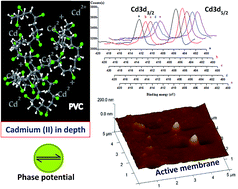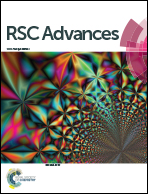Depth profiling X-ray photoelectron spectroscopy and atomic force microscopy of Cd(ii)- and Pb(ii)-selective electrodes based on nano metal sulfides
Abstract
This research involved constructing and studying plastic membrane Cd(II)- and Pb(II)-ion selective electrodes of the coated wire type based on nanoparticles of CdS and PbS as ionophores, respectively. The electrodes exhibited average linear concentration ranges of 1.0 × 10−6 to 1.0 × 10−2 and 9.6 × 10−7 to 1.0 × 10−2 M, average detection limits of 8.6 × 10−7 and 5.8 × 10−7 M, pH ranges of 2.2–5.8 and 2.9–5.9, and average calibration graph slopes of 28.56 and 28.81 mV per concentration decade, respectively. Both electrodes showed high selectivity towards many inorganic cations. Depth profiling X-ray photoelectron spectroscopy of fresh and expired membranes proved that: (a) the nanoparticles were homogeneously dissolved in the polymeric network and (b) the limitation of the life span of the plastic membrane was due to leaching of the active ingredient from the membrane surface to the bathing solution. The topography of fresh, active, and expired membranes as imaged by atomic force microscopy revealed the formation of a gel layer at the surface of the active electrode and drastic deformation of the expired membrane's surface.



 Please wait while we load your content...
Please wait while we load your content...